Genetic labeling of steroidogenic factor-1 (SF-1) neurons in mice reveals ventromedial nucleus of the hypothalamus (VMH) circuitry beginning at neurogenesis and development of a separate non-SF-1 neuronal cluster in the ventrolateral VMH
- PMID: 22987798
- PMCID: PMC4304766
- DOI: 10.1002/cne.23226
Genetic labeling of steroidogenic factor-1 (SF-1) neurons in mice reveals ventromedial nucleus of the hypothalamus (VMH) circuitry beginning at neurogenesis and development of a separate non-SF-1 neuronal cluster in the ventrolateral VMH
Abstract
The ventromedial nucleus of the hypothalamus (VMH) influences a wide variety of physiological responses. Here, using two distinct but complementary genetic tracing approaches in mice, we describe the development of VMH efferent projections, as marked by steroidogenic factor-1 (SF-1; NR5A1). SF-1 neurons were visualized by Tau-green fluorescent protein (GFP) expressed from the endogenous Sf-1 locus (Sf-1(TauGFP)) or by crossing the transgenic Sf1:Cre driver to a GFP reporter strain (Z/EG(Sf1:Cre)). Strikingly, VMH projections were visible early, at embryonic (E) 10.5, when few postmitotic SF1 neurons have been born, suggesting that formation of VMH circuitry begins at the onset of neurogenesis. At E14.5, comparison of these two reporter lines revealed that SF1-positive neurons in the ventrolateral VMH (VMH(vl)) persist in Z/EG(Sf1:Cre) embryos but are virtually absent in Sf-1(TauGFP). Therefore, although the entire VMH including the VMH(vl) shares a common lineage, the VMH(vl) further differentiates into a neuronal cluster devoid of SF-1. At birth, extensive VMH projections to broad regions of the brain were observed in both mouse reporter lines, matching well with those previously discovered by injection of axonal anterograde tracers in adult rats. In summary, our genetic tracing studies show that VMH efferent projections are highly conserved in rodents and are established far earlier than previously appreciated. Moreover, our results imply that neurons in the VMH(vl) adopt a distinct fate early in development, which might underlie the unique physiological functions associated with this VMH subregion.
Copyright © 2012 Wiley Periodicals, Inc.
Conflict of interest statement
The authors have no conflict of interest and nothing to disclose.
Figures


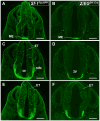
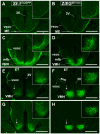
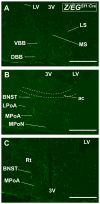


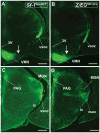

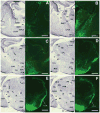

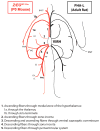
Similar articles
-
Altered position of cell bodies and fibers in the ventromedial region in SF-1 knockout mice.Exp Neurol. 2011 Dec;232(2):176-84. doi: 10.1016/j.expneurol.2011.08.021. Epub 2011 Aug 30. Exp Neurol. 2011. PMID: 21906594 Free PMC article.
-
Conditional viral tracing reveals that steroidogenic factor 1-positive neurons of the dorsomedial subdivision of the ventromedial hypothalamus project to autonomic centers of the hypothalamus and hindbrain.J Comp Neurol. 2013 Oct 1;521(14):3167-90. doi: 10.1002/cne.23338. J Comp Neurol. 2013. PMID: 23696474
-
Loss of steroidogenic factor 1 alters cellular topography in the mouse ventromedial nucleus of the hypothalamus.J Neurobiol. 2004 Sep 15;60(4):424-36. doi: 10.1002/neu.20030. J Neurobiol. 2004. PMID: 15307147
-
SF-1 in the ventral medial hypothalamic nucleus: a key regulator of homeostasis.Mol Cell Endocrinol. 2011 Apr 10;336(1-2):219-23. doi: 10.1016/j.mce.2010.11.019. Epub 2010 Nov 24. Mol Cell Endocrinol. 2011. PMID: 21111025 Free PMC article. Review.
-
Development of the ventromedial nucleus of the hypothalamus.Front Neuroendocrinol. 2006 Jul;27(2):193-209. doi: 10.1016/j.yfrne.2006.02.002. Epub 2006 Apr 17. Front Neuroendocrinol. 2006. PMID: 16603233 Review.
Cited by
-
An estrogen-responsive module in the ventromedial hypothalamus selectively drives sex-specific activity in females.Cell Rep. 2015 Jan 6;10(1):62-74. doi: 10.1016/j.celrep.2014.12.011. Epub 2014 Dec 24. Cell Rep. 2015. PMID: 25543145 Free PMC article.
-
Essential and sex-specific effects of mGluR5 in ventromedial hypothalamus regulating estrogen signaling and glucose balance.Proc Natl Acad Sci U S A. 2020 Aug 11;117(32):19566-19577. doi: 10.1073/pnas.2011228117. Epub 2020 Jul 27. Proc Natl Acad Sci U S A. 2020. PMID: 32719118 Free PMC article.
-
GHRH Neurons from the Ventromedial Hypothalamic Nucleus Provide Dynamic and Sex-Specific Input to the Brain Glucose-Regulatory Network.Neuroscience. 2023 Oct 1;529:73-87. doi: 10.1016/j.neuroscience.2023.08.006. Epub 2023 Aug 10. Neuroscience. 2023. PMID: 37572878 Free PMC article.
-
Rax is a selector gene for mediobasal hypothalamic cell types.J Neurosci. 2013 Jan 2;33(1):259-72. doi: 10.1523/JNEUROSCI.0913-12.2013. J Neurosci. 2013. PMID: 23283339 Free PMC article.
-
Hypothalamic control of energy expenditure and thermogenesis.Exp Mol Med. 2022 Apr;54(4):358-369. doi: 10.1038/s12276-022-00741-z. Epub 2022 Mar 17. Exp Mol Med. 2022. PMID: 35301430 Free PMC article. Review.
References
-
- Cameron NM, Soehngen E, Meaney MJ. Variation in maternal care influences ventromedial hypothalamus activation in the rat. J Neuroendocrinol. 2011;23:393–400. - PubMed
Publication types
MeSH terms
Substances
Grants and funding
LinkOut - more resources
Full Text Sources
Other Literature Sources
Molecular Biology Databases

